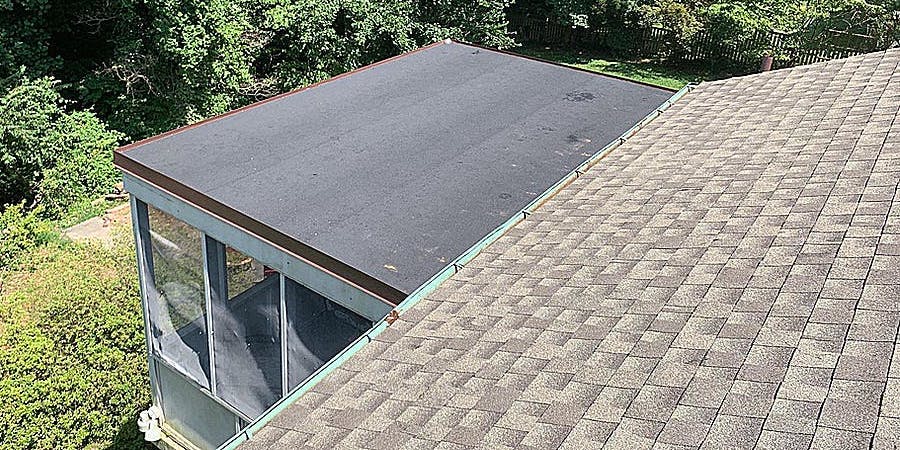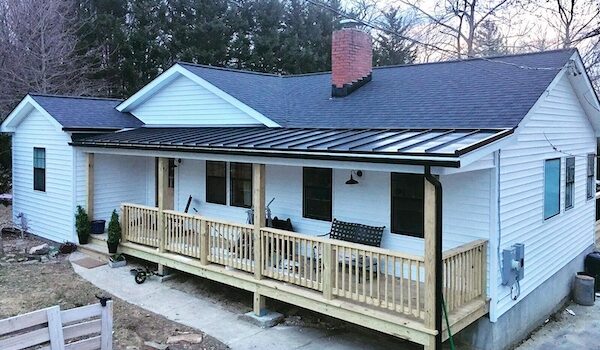A roof extension gives a home new space, better coverage, and a cleaner architectural finish. Homeowners across Maryland often choose this project when their property feels tight or when they want a more functional layout without moving. RoofPRO helps families make smart changes by adding strong, durable roof structures that match the style of the home and meet the building requirements for our region. The result is a cleaner connection between old and new spaces with weather protection that lasts through Maryland’s seasonal shifts.
What Is a Roof Extension?
A roof extension adds new roof coverage to an existing house. Some homeowners add a small structure over a porch or patio. Others extend an entire section of the home to add living space or improve storage. The basic idea stays the same. The new roofing ties into the old system, and everything works together to keep water, heat, and wind away from the living spaces below.

How Roof Extensions Work
A roof extension begins with measurements of the existing home. This ensures that the new section sits at the correct height and pitch. The structure must carry live and dead loads, which is why our inspectors study your house’s framing, connection points, and the limits of the current system. Our roof installers then create the support structure and add sheathing, underlayment, flashing, and roofing materials that match or improve the current system.
Reasons Homeowners Choose a Roof Extension
Families often reach a point where their home layout feels limited. A roof extension gives a simple way to create new coverage or expand interior square footage. Common reasons include new porches, bedrooms, larger kitchens, covered walkways, safer entry doors, and outdoor areas that stay dry when it rains. Maryland homeowners also choose extensions to improve home value or prepare for multi-generation living.
Roof Extension vs Roof Replacement: Which Do You Need?
A roof extension makes sense when you are changing the footprint of your home. On the other hand, a full roof replacement fits situations where:
- The roof is aging, curling, or losing granules
- There are chronic leaks or storm damage over a wide area
- You want to upgrade to a better shingle or a new color
Sometimes the smart move is to combine both. If your existing roof is near the end of its life and you are planning an addition, we often recommend replacing the main roof at the same time as building the extension. That way, all the shingles match, the flashing is renewed, and you get one unified warranty period. We walk homeowners through both paths and explain the tradeoffs, so the final scope fits your budget and long-term plans.
Common Types of Roof Extensions
Roof extensions vary by shape, slope, and purpose. Choosing the right style depends on the height of the original structure, the size of the addition, and how the roof will handle rainwater. Maryland’s climate pushes certain designs to the front because reliable drainage is essential during storms.
Flat or Low-Slope Extensions
Flat or low-slope roofs work for modern additions or raised deck areas. They require careful waterproofing and high-quality materials. TPO and torch-down systems appear often in these projects because they handle pooling water better than shingles. Maryland homes with second-story extensions sometimes use these low-slope sections to avoid conflicts with nearby rooflines or windows.
Shed Roof Extensions
A shed roof extension slopes in one direction. This simple design works well for single-story bump-outs or small room expansions. The slope sends water toward one side, which helps in areas with frequent rainfall. Many homeowners choose this style for laundry rooms, mudrooms, or smaller kitchen additions because framing remains straightforward and affordable.
Gable Roof Extensions
A gable extension creates a peaked shape with two sloping sides. It works for larger additions and blends easily with many Maryland home styles. The peak improves drainage and allows more space for attic ventilation. If the original roof uses a gable design, extending that shape provides a cleaner visual fit.
Hip Roof Extensions
Hip roof extensions slope on all sides. This design holds up well against strong winds, which matter in wide or open yards. Hip roofs appear on many porch additions and multi-directional rooflines. They also support balanced water flow, reducing pressure on gutter systems.
Second-Story Roof Extensions
A vertical extension adds a full upper level. This work requires structural evaluation, engineering, and a clear roof plan. A second-story addition completely changes the home’s profile. Many families pursue this upgrade when they want more living space without moving to a larger property.

Key Planning Factors Before Extending a Roof
Creating a dependable roof extension means understanding how the new section interacts with the original home. A smooth exterior appearance matters, but the elements you cannot see matter even more.
Structural Load and Engineering
The new roof must distribute weight correctly. Rafters, ridge boards, support beams, and load-bearing walls all factor into the design. Maryland codes require specific framing methods, and inspectors check attachment points carefully. We regularly collaborate with engineers when projects need additional structural evaluation.
Waterproofing and Weather Protection
Improper waterproofing leads to leaks, mold, and interior damage. Flashing at roof joints, valleys, skylights, and chimneys must fit perfectly. Ice and water shield, synthetic underlayment, and high-quality shingles play critical roles during Maryland’s freeze-thaw cycles. Even a small gap can cause long-term problems.
Matching Roofing Materials
Homeowners often want roofing materials that blend with the original roof. Architectural shingles from Owens Corning or CertainTeed offer close color matches, although older roofs may require replacement for perfect consistency. Metal roofing can also be used for specific extensions, especially when slope or style calls for it.
Ventilation and Insulation
A roof extension changes how air moves through the attic. Without proper ventilation, heat and moisture can collect inside the structure. That creates condensation, high energy bills, and faster shingle wear. We examine how soffits, ridge vents, and attic channels will behave once the new roofline connects with the existing roof.
Drainage and Gutter Adjustments
Every roof extension affects roof drainage, gutter systems, and rainwater flow. Downspouts may need repositioning, gutter sizes may need upgrading, and the slope of the extension should move water away from sensitive exterior areas. Proper drainage reduces erosion and siding damage.
Permitting and Maryland Building Codes
Maryland counties set clear rules for additions and roofing work. Baltimore, Anne Arundel, Montgomery, Howard, and Prince George’s counties inspect framing, roofing, and attachment methods. RoofPRO handles permitting requirements and meets all local code standards.

How RoofPRO Builds Long-Lasting Roof Extensions
We follow a structured process that gives homeowners a clear picture of what to expect. Each step prevents problems before they start.
Detailed Assessment and Design
Our team examines the home’s roofline, attic space, framing, and drainage pathways. We measure slope, pitch, and structural elements with tools used across the industry.
Expert Tie-In Installation
Connecting a new roof section to an existing one requires precision. We cut and place the framing components carefully so everything matches the original structure. Flashing and underlayment get installed with attention to every joint. Mistakes in this step cause leaks, so we treat it as the most critical stage.
Material Matching and Upgrades
We check the age and condition of the original roof. When shingles show heavy wear, color matching becomes difficult. In those cases, homeowners receive recommendations for partial or full replacement. This ensures a smooth, unified appearance while improving long-term performance.
Code-Compliant Roofing and Framing
We follow Maryland’s building standards on every project. Proper nailing patterns, board sizes, ridge ventilation, drip edge placement, and attic airflow all matter. Our crews maintain these standards from start to finish.
Cleanup and Final Walkthrough
We remove old materials, clean the worksite, and show homeowners every change made to the roofline. The walkthrough gives families a chance to understand how the new roof protects their addition.
Why Maryland Homeowners Choose RoofPRO
RoofPRO has served Maryland communities for more than twenty years. We understand the roofing needs of homes built across different decades. Our teams handle complex rooflines, structural tie-ins, and varied roofing materials. When homeowners call with concerns about matching shingles, structural load, or county approvals, we explain every part of the process so they feel confident in the plan.
People choose us because we offer:
- Local experience with Maryland codes and weather patterns.
- High-quality roofing products with reliable warranties.
- Skilled crews trained on shingles, metal roofing, TPO systems, and framing.
- Clear communication throughout the project.
- A strong reputation backed by long-term customer relationships.
Request a Roof Extension Quote in Maryland
RoofPRO helps homeowners plan a design that fits their property, budget, and long-term goals. If you want more space or a cleaner covered area around your home, schedule an on-site consultation today. The RoofPRO team will review your ideas, gather measurements, and create a clear plan for your upgrade.

Author Bio
Tim Taylor – Owner & Founder of RoofPRO
Tim Taylor began his roofing career in 2003 and founded RoofPRO in 2004 with a mission to fix the poor workmanship that often causes roof leaks. With over 20 years of hands-on experience, he’s earned elite credentials like CertainTeed’s ShingleMaster Wizard certification, HAAG inspection certifications, and OSHA safety training. His expertise in leak repair, flashing repair, and post-storm restoration has made RoofPRO one of Maryland’s most trusted roofing companies. Tim continues to lead with the same principle that built his reputation—roof it right the first time.

